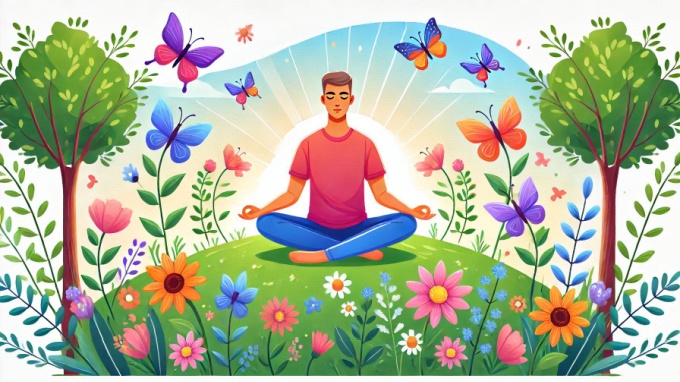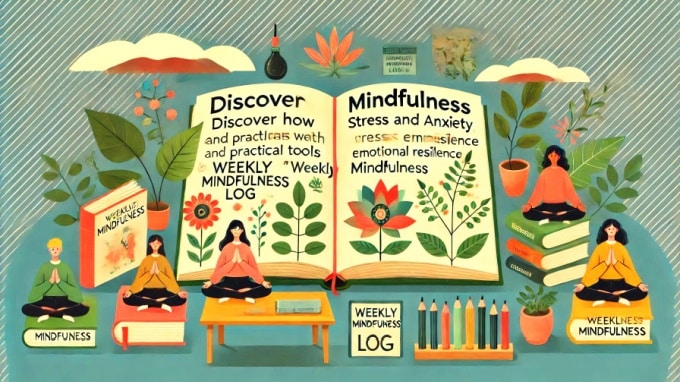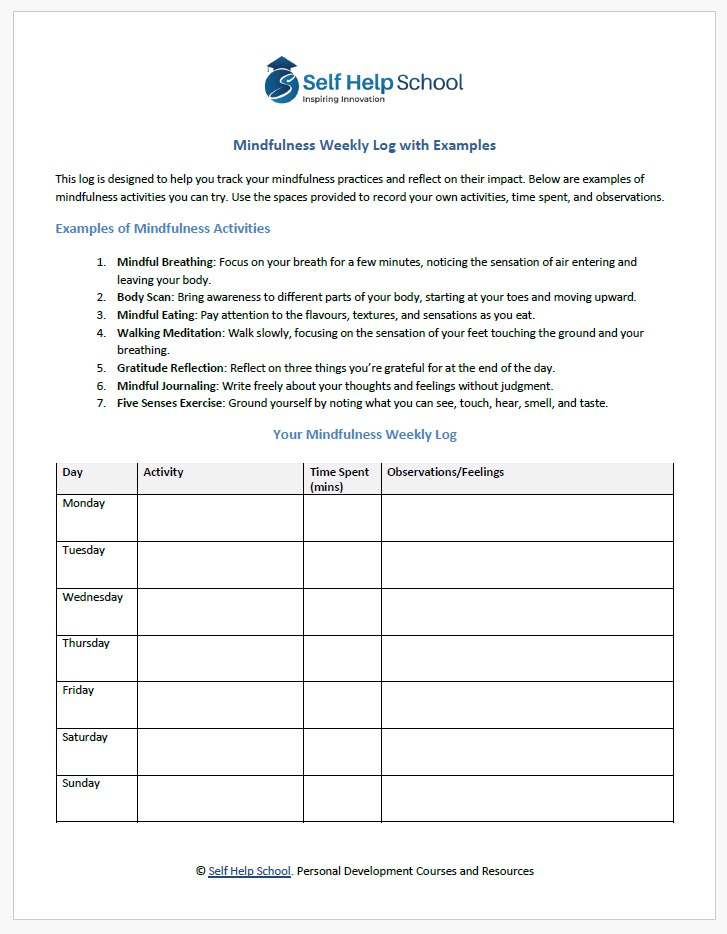The Mindfulness Advantage
Mindfulness isn’t just a trendy buzzword. It’s a transformative tool backed by science and used by millions to cultivate inner peace, reduce stress, and enhance emotional resilience.
Recent research reveals that even just 10 minutes of mindfulness each day can make a meaningful difference in reducing stress and enhancing mental well-being.
A study published on ScienceDaily highlights the power of short mindfulness practices to improve emotional health and support positive behavioural changes. Imagine that—a small daily habit with the power to significantly improve your mental well-being!.
Whether you’re a therapist guiding clients or someone eager to embrace mindfulness for personal growth, this article will break down what mindfulness really means, how it works, and how you can start benefiting today.
You can also begin to track your mindfulness journey using the Weekly Mindfulness Log below.
What Mindfulness Means
At its core, mindfulness is about being fully present in the moment. It’s the practice of focusing your attention on the here and now without judgment. No overthinking the past or worrying about the future—just being.
Jon Kabat-Zinn, who developed Mindfulness-Based Stress Reduction (MBSR), defines mindfulness as “paying attention in a particular way: on purpose, in the present moment, and non-judgmentally.”.
Mindfulness is simple, but it’s not always easy. Our brains are wired to wander. The good news? Like a muscle, mindfulness strengthens with practice.
Who Invented Mindfulness?
While mindfulness has roots in ancient Buddhist meditation practices, it’s not exclusively spiritual or religious. Modern mindfulness owes much to Kabat-Zinn, who introduced it to the West in the 1970s.
His goal? To make mindfulness accessible to everyone, no matter their background.
Since then, mindfulness has been widely adopted in clinical settings to help manage stress, chronic pain, and mental health conditions. But it’s just as effective for anyone seeking clarity and calm in a chaotic world.

Is Meditation the Same Thing?
Not quite! Mindfulness and meditation are closely related but distinct. Think of mindfulness as the broader concept of present-moment awareness and meditation as a specific technique to cultivate it.
You can practise mindfulness during everyday activities—washing dishes, walking, or even eating. Meditation, on the other hand, involves setting aside dedicated time to sit quietly and focus, often on your breath or a mantra.
Both are valuable, but mindfulness is wonderfully versatile. It can be integrated into your life anytime, anywhere.
How Mindfulness Can Empower You
Mindfulness is like a mental reset button. When practised consistently, it offers profound benefits:
- Emotional Regulation – By observing your thoughts without judgment, you gain the power to respond thoughtfully rather than react impulsively.
- Improved Focus – Mindfulness strengthens your ability to concentrate. Research shows it can enhance cognitive performance and decision-making.
- Stress Reduction – By anchoring yourself in the present, you prevent your mind from spiralling into unhelpful thought patterns.
- Greater Self-Awareness – You become more attuned to your emotions and triggers, which is invaluable for personal growth and therapeutic work.
Is Mindfulness Effective for Reducing Stress?
Absolutely. Stress often stems from ruminating on what’s already happened or worrying about what might. Mindfulness cuts through this cycle by grounding you in the present.
A study published in JAMA Internal Medicine found that an eight-week mindfulness program significantly reduced participants’ stress levels.
Simple practices like mindful breathing can lower cortisol (the stress hormone), creating a sense of calm.

Will it Help with Anxiety?
Yes, mindfulness is an excellent tool for managing anxiety. It teaches you to observe anxious thoughts without being consumed by them.
Instead of identifying with “I am anxious,” mindfulness allows you to reframe it as “I am experiencing anxious thoughts.” This subtle shift fosters a sense of control, and begins to program your unconscious focus towards mastery.
Mindfulness techniques such as grounding exercises and mindful breathing can interrupt the cycle of worry, helping you regain balance during moments of heightened anxiety.
How to Practise Being Mindful in Everyday Life
Being Mindful doesn’t require hours of meditation or special equipment. With a few small adjustments, you can incorporate it into daily life and start reaping the benefits.
Here are practical mindfulness techniques to try, complete with examples for clarity:.
- Mindful Breathing – Spend a few minutes focusing solely on your breath. Notice the sensation of air entering through your nose and filling your lungs, then leaving your body as you exhale. If your mind starts to wander (and it will), gently bring your attention back to your breath.
Example: Pause during a stressful workday and close your eyes. Inhale deeply for four counts, hold for four, and exhale for four. Repeat for five minutes to reset and refocus.
- Body Scan – This practice involves bringing awareness to different parts of your body, from head to toe. It’s a great way to release tension and reconnect with your physical self.
Example: Before bed, lie down and focus on each body part, starting with your toes and moving up to your head. Notice any sensations, tightness, or relaxation.
This simple practice can help you unwind and improve sleep.
- Eating – Eating mindfully is about paying full attention to your food. Notice the colours, textures, and flavours without distractions like your phone or TV.
Example: Next time you eat a piece of chocolate, slow down. Smell it first. Place it on your tongue and notice the texture before chewing.
Savour the flavour, letting it melt slowly. This turns eating into a sensory experience.
- Walking Meditation – Walking meditation combines movement with mindfulness. Instead of rushing to your destination, walk slowly and focus on the sensation of your feet touching the ground, your breath, and the rhythm of your movement.
Example: During your lunch break, find a quiet path. Walk slowly and notice each step—how your heel meets the ground, how your weight shifts, and how your toes push off.
If your mind wanders, gently guide it back to the act of walking. Walking meditation can be grounding and rejuvenating, especially when done in nature.
Further Methods
- Gratitude Reflection – Gratitude reflection helps you shift focus from what’s lacking to what’s abundant in your life. By regularly practising gratitude, you cultivate a positive mindset and greater emotional resilience.
Example: At the end of each day, think of three things you’re grateful for. Write them down or say them aloud. Be specific—rather than “I’m grateful for my family,” try “I’m grateful for the heartfelt conversation I had with my sister today.” This specificity enhances the emotional impact of the exercise.
- Journaling – Journaling mindfully involves writing with intention and awareness. It’s a space to explore your thoughts, emotions, and experiences without judgment.
Example: Dedicate 10 minutes each morning or evening to journaling. Begin with a simple prompt like, “What am I feeling right now?” Write freely without worrying about grammar or structure.
As you write, notice patterns in your thoughts or emotions. This practice helps you process your inner world and identify areas for growth. To help you with this you can download our free Reflective Moments Yearly Journal.
- Five Senses Exercise – This is a quick grounding exercise that brings you into the present moment by engaging all your senses.
Example: Pause and notice:.
- 5 things you can see (e.g., a plant, the sky).
- 4 things you can touch (e.g., the fabric of your clothes).
- 3 things you can hear (e.g., birds chirping).
- 2 things you can smell (e.g., coffee brewing).
- 1 thing you can taste (e.g., the mint from your gum).
This is especially useful during stressful moments or when you feel overwhelmed.
Incorporating these mindfulness techniques into your day doesn’t require extra time—just a shift in how you approach everyday activities.
By practising these exercises regularly, you’ll build greater awareness, deeper unconscious connection, reduce stress, and create a deeper connection to the present moment.

Your Weekly Log
Tracking your mindfulness practice helps you stay committed and notice patterns. Here’s a simple weekly log to guide your progress:.
Mindfulness Weekly Log PDF Download
Conclusion: Making Mindfulness Work for You
Mindfulness isn’t just a practice—it’s a lifestyle. Whether you’re seeking stress relief, anxiety management, or simply a deeper connection to yourself, mindfulness offers a path to greater well-being.
Start small, stay consistent, and remember: every mindful moment is a step toward a more centred, empowered you.

Dr Sandra Westland is a #1 bestselling author and Advanced Existential Psychotherapist, in full time practice since 1999. She is also co-founder of Self Help School. She previously worked for many years in education as a highly qualified senior teacher in secondary schools, leaving to work in a private psychiatric hospital and then onto becoming a full-time therapist, where she now divides her time between a successful private practice in Essex and online, writing books, courses, and undertaking research in various psychological subjects.


